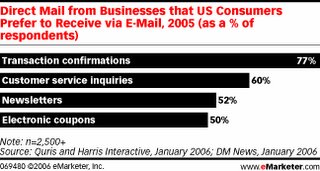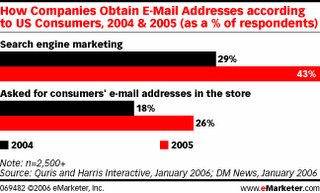E-mail Marketing: vantaggi e problemi
Via eMarketer riporto un'altra ricerca che mira a definire gli obiettivi di comunicazione che permettono di ottenere i migliori risultati nelle campagne E-mail marketing in base ai comportamenti degli utenti.
Questa volta la ricerca traccia i contorni del gap esistente tra l'informazione che l'utente richiede dalla mail e ciò che invece ne viene tratto effettivamente.
Surprisingly, although 77% of consumers report wanting to receive offers from marketers — and you would think that is exactly what marketers would want to send — only 8% reported getting them.

"There is a gap between consumers' expectations and what companies push out," Katie Cole of Quris told DM News, in something of an understatement.
The good news is that the gap may be narrowing, at least in certain categories.
When asked what permission e-mail does best, 66% of the respondents said purchase, shipping and transaction confirmation, and that figure is up from 58% in 2004. An additional 48% said permission e-mail is best for providing electronic statements or other account information, and another 43% said is best for promoting special discounts and other limited-time offers.

Taken together, 51% of the respondents had no problem receiving e-mail marketing messages within those service categories.
As a result, the Quris report recommends combining service and marketing messages: "The key is to provide the valued service first and then target receptive consumers with relevant content or offers within those messages."
While many marketers are switching from direct mail to e-mail for more of their customer communications, it seems they are not transitioning quick enough for many consumers — who want e-mail to replace more of the direct mail pieces they currently receive from businesses.
In fact, 77% of the respondents said e-mail was the better medium for transaction confirmations, 60% said it was better for customer service inquiries and a bare majority said newsletters and electronic coupons should be sent by e-mail.

On the other hand, most consumers still want their magazines and newspapers delivered directly by good old snail mail.
The one thing businesses must do better is explain how e-mail addresses are collected. Spam has many consumers suspicious, and — rightly or wrongly — 53% of the respondents think the main source of spam is companies sharing their addresses without permission, and many others attribute spam to partnership marketing. That is no way to build a trusting relationship.

The truth is today more companies are getting their in-house e-mail addresses from search marketing campaigns. The percentage of e-mail addresses obtained that way is up to 43%. Companies obtain 26% of their consumer e-mail addresses in-store.






0 Comments:
Posta un commento
<< Home